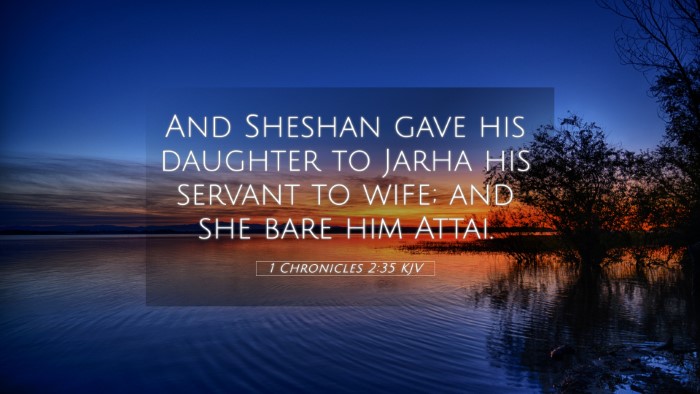1 Chronicles 2:35 - Summary and Commentary
The verse 1 Chronicles 2:35 states, "And Sheshan gave his daughter to Uriah his son, and she bare him Ahitub." This passage may appear simple, yet it opens up avenues for deeper exploration into genealogies and relationships within the biblical text.
Understanding the Context
The context of this verse lies within the genealogical record of the tribe of Judah. This account provides vital information about the lineage and the connections among key figures in biblical history.
Insights from Public Domain Commentaries
-
Matthew Henry: Matthew Henry notes the importance of genealogies in establishing the heritage of the tribes of Israel. He emphasizes that Sheshan's action in giving his daughter in marriage to Uriah the son reflects both familial alliances and the continuation of Davidic lineage.
-
Albert Barnes: Albert Barnes discusses the significance of this union. He points out that Uriah, who is also referenced in 2 Samuel, is known for his loyalty and tragic end. This connection may serve to highlight the theme of loyalty and betrayal within David's court.
-
Adam Clarke: Clarke elaborates on the genealogical implications, emphasizing how marriages among tribes not only aim to preserve lineage but also to strengthen mutual bonds. He notes the role these connections play in the broader narrative of Israel's history.
Cross-References Related to 1 Chronicles 2:35
- The story of Uriah the Hittite: 2 Samuel 11
- The genealogy of the tribe of Judah: Genesis 49:8-10
- The role of Sheshan in Judah's lineage: 1 Chronicles 2:31
- Covenants and genealogies in Scripture: Matthew 1:1-16
- Relationship dynamics in the Bible: Ruth 4:13-22
- Historical significance of marriage alliances: 1 Kings 11:1-4
- The importance of lineage in priestly duties: Ezra 2:62-63
Thematic Analysis
The familial connections outlined in this verse reflect a broader biblical theme regarding the significance of lineage and the importance of relationships in the formation of identity within the Israelite community.
Furthermore, the act of marriage often symbolizes alliances that were crucial for the tribes’ survival and unity, a theme prevalent in various narratives throughout the Scriptures.
Cross-Referencing the Themes
When engaging in a deeper analysis of this verse, one can utilize cross-referencing Bible study methods, enabling readers to draw parallels and contrasts between related passages. This approach not only enriches understanding but also provides insights into God's overarching plan as revealed in the scriptures.
Tools for Bible Cross-Referencing
To explore connections between Bible verses thoroughly, various bible reference resources can be utilized, including:
- Bible Concordance
- Bible Cross-Reference Guide
- Comprehensive Bible Cross-Reference Materials
- Online Bible Study Tools
Conclusion
In summary, 1 Chronicles 2:35 encapsulates a moment that may seem trivial at first glance but reveals profound insights into the lives of those in God’s chosen line. By applying a comparative Bible verse analysis, we can discern how this genealogy fits into the larger narrative, revealing God's providence through familial ties.
SEO Considerations
The content presented here serves to facilitate a comprehensive bible cross-reference study. Users searching for bible verses that relate to each other will find helpful insights that lead them into deeper understanding and appreciation of the text.
For those interested in identifying connections between Old and New Testament verses, exploring links between the Prophets and Apostolic teachings becomes clearer through the study of genealogies such as that in this passage.


